Barn Quilts Piece Together a Community
Riding the roads that cut through the farm fields of Shawano County, Wisconsin, yields one colorful surprise after another. The county, located near the middle of the state, is home to nearly 50,000 people, an untold number of dairy cows and 305 8-by-8-foot barn quilts.
A barn quilt is a quilt block design painted on a large piece of wood and hung on a barn. Although barn quilts exist around the country, if you’ve traveled the backroads of the midwestern and southern United States, you’ve likely easily spotted them soaring over lush green fields of corn and alfalfa. The trend reportedly gained traction in Ohio in 2001, when Donna Sue Groves honored her mother by attaching one to her family barn — from there, the quilt blocks started popping up like milkweed in the spring. Today, the practice is a bona fide movement, and Suzi Parron (the author with Groves of a book about the practice) maintains a website that includes a guide to quilt trails around the country.
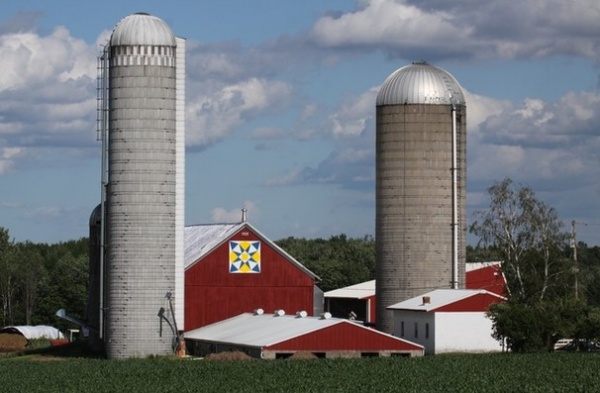
Photos by Jim Leuenberger
Shawano County reportedly has more 8-by-8 barn quilts than any other place in the United States, and it all started with an idea hatched on a long drive from Wisconsin to Kentucky. It’s a route Jim Leuenberger takes often, because the Shawano County resident likes to visit his sister who lives in the Bluegrass State. He had grown up on a dairy farm in Iowa, and so he was right at home when his work as a public relations professional at a cattle breeding corporation took him to Shawano, another dairy community.
But life was changing in the county; more and more families were getting out of the milk business. Many of the large dairy barns were empty, and some were falling into disrepair. Leuenberger, who had just retired, looked at the quilts rolling by as he drove on the interstate and thought, “Wouldn’t it be neat to start a barn quilt trail in Shawano?” That flicker of a vision grew into something much, much larger — an idea that blanketed the community, giving new life to old barns and drawing the residents even more closely together.
Leuenberger approached Patti Peterson, tourism manager at the local chamber of commerce about the idea, and she was sold. The harder sell was his wife, Irene. Although she was in favor, one question gave her pause. “Who will paint all of these?” she asked Leuenberger. Hesitation turned to concern when he answered, “We will!” (She confesses, “I thought he was crazy.”)
Now, with hundreds of quilts under their belt, the couple are quilt-painting pros (quilts are also painted by 4-H groups and the Shawano Barn Quilt Committee). Leuenberger notes that each quilt has a history, and many are beautiful tributes. Here are a few of the stories behind the quilt blocks.
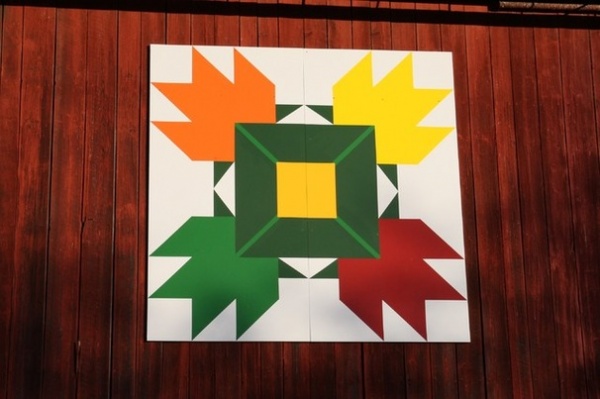
Barn Quilt 103: Autumn Leaves
The maple leaves in this quilt block are a fitting tribute to Milton Mehlberg, who has been producing maple syrup on this farm since 1951. (The farm has been in his family since 1872, when his great-grandfather Julius built a log cabin on the property.)
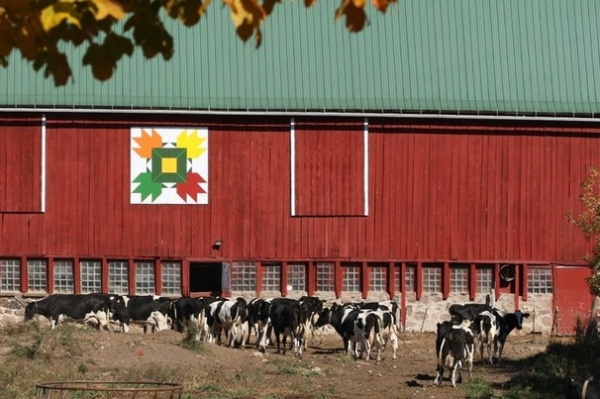
The farm is 240 acres. On 80 of those grow maple trees that supply Mehlberg’s Maple Syrup.
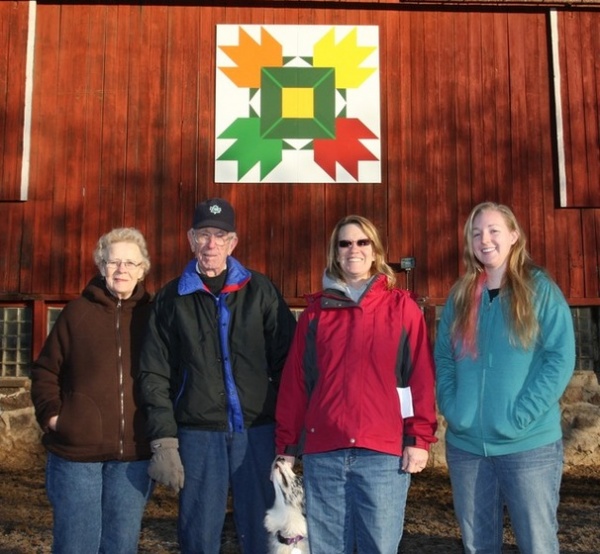
Today Mehlberg and his children own the farm. Daughter Lori Egdorf and her husband manage a small dairy herd on it. Egdorf commissioned the quilt in honor of her dad. Part of the family is seen here, from left: Ramona Mehlberg, Milton Mehlberg, Lori Egdorf and her daughter.
In an interview with Leuenberger (he’s working on a book about the project), Egdorf says: “It’s a nice tribute to my dad, who loves the outdoors and enjoys working with the maple syrup business on our farm.”
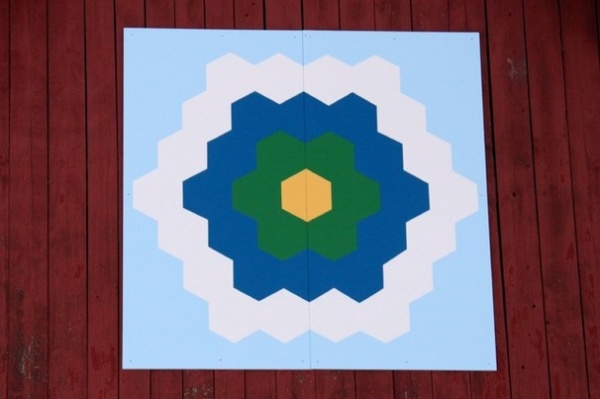
Barn Quilt 111: Grandmother’s Quilt (Grandmother’s Garden)
This quilt block was commissioned by Kathi Polzin. It is a copy of a quilt made by Julia Sorenson, grandmother of her late husband, Tom. Sorenson handcrafted the quilt that inspired the design from flour sacks.
The colors are symbolic: The cobalt blue is Kathi’s favorite color, and the yellow was Tom’s hue of choice. The green represents life and undying love, and the sky blue speaks to Tom’s passion for space and aviation.
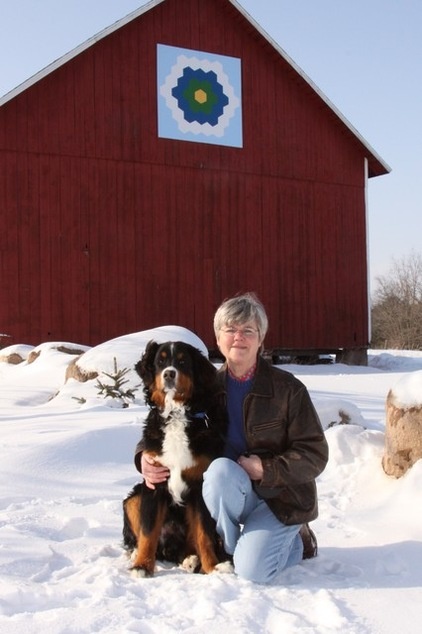
Kathi’s ancestors, the Holms, started farming here in 1890 (her forebears developed the Holm Automatic Sharpener, a device that keeps silo filler knives razor sharp, on this property).
Kathi, a retired English and journalism professor, purchased the farm in 1987. She has restored the original farmhouse, barn and fieldstone silo. She maintains 10 acres of reclaimed wetlands, 20 acres of prairie grasses and flowers (which serve as a habitat for the rare blue lupine plant and the endangered Karner blue butterfly). A portion of the spread is a Christmas tree farm and a managed woodland tree farm.
Kathi is seen here with Roosevelt, her Bernese mountain dog.
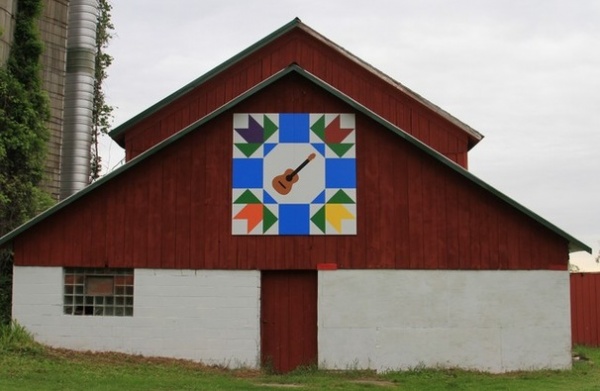
Barn Quilt 269: Always in Tune
This quilt block, sponsored by Tom Whitemarsh, is displayed on a barn owned by Cliff and Eileen Elertson. The guitar in the center is a tribute to Cliff’s music career. He was raised on this farm (it was a stagecoach stopover in 1868 and was purchased by his parents in 1942), but left to go to Nashville, where he wrote and recorded songs. Today he plays with a local band called Country Partners.
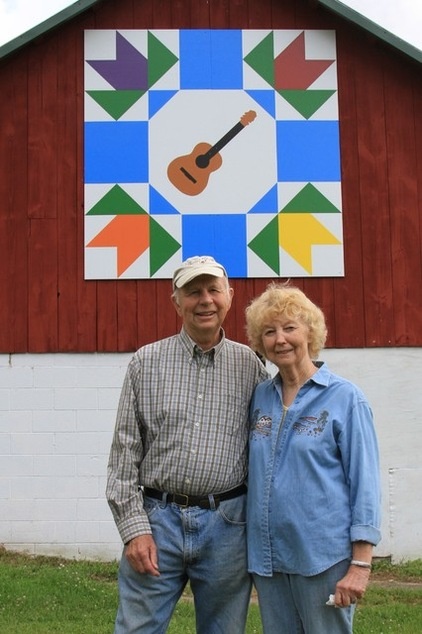
The Elertsons, seen here, reside in the original farmhouse, and they have lived on the 160-acre farm since 1959. They managed a dairy herd that, at its peak, had nearly 100 head of cattle.
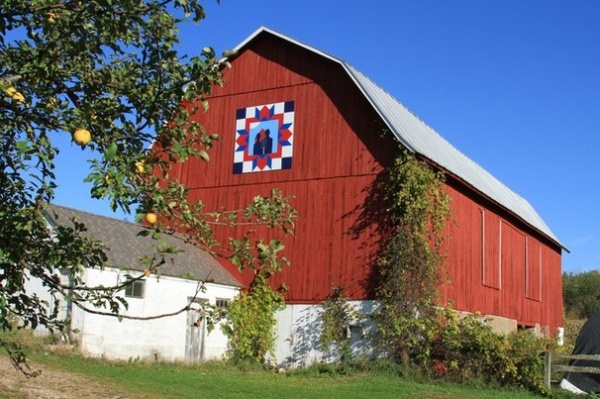
Barn Quilt 272: Friendship (An American Gothic Theme)
Dennis and Katherine Buntrock owe a lot to the late Carl and Gertrude Routzahn. The Buntrocks purchased this farm from the Routzahns, and Dennis credits them with teaching him a lot about farming.
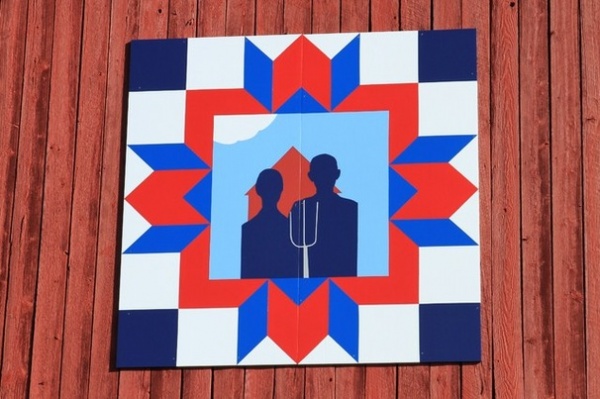
Leuenberger reports that the iconic couple depicted in Grant Wood’s famous American Gothic painting reminded the Buntrocks of the late Routzahns, so including the motif in the design felt right. This quilt is also sponsored by Tom Whitemarsh.
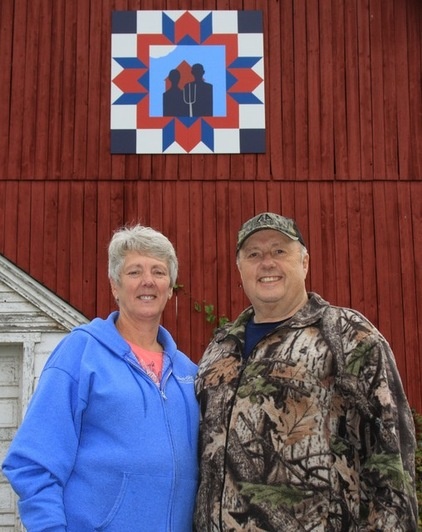
The Buntrocks, seen here, purchased the farm in 1990, and they have been raising crops there ever since. They became close friends with the Routzahns and, in one of the best farm community traditions, shared machinery and labor to run their respective outfits. The relationship between the two families inspired the name Friendship for this barn quilt.
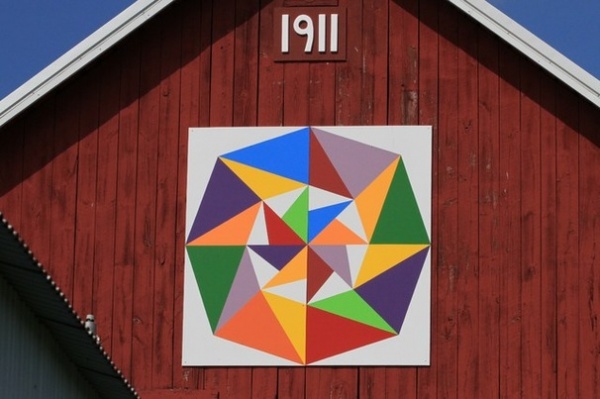
Barn Quilt 258: Joseph’s Coat
In Shawano County, barn quilts can be sponsored or purchased (the money covers the materials used to craft and hang the squares). This quilt square was sponsored by the Shawano Hospice Group, and it adorns the 105-year-old barn owned by Charles and Pam Daily.
The old barn was built with local field stone, oak flooring and pine siding. The original shake roof has been covered with metal to preserve the structure. In its lifetime, the barn has been used as a stable, a cattle barn and a milking barn.
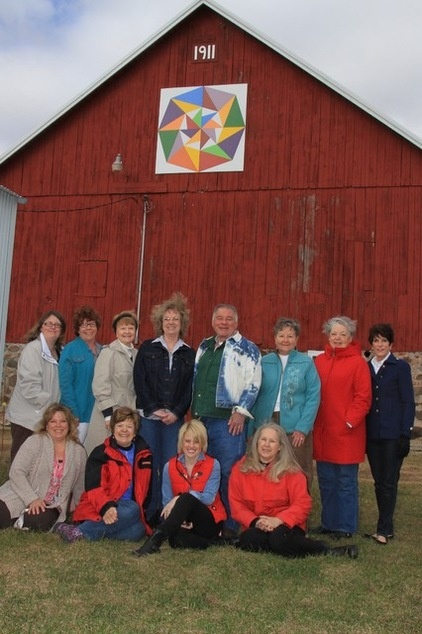
Pictured here are the members of the Shawano Area’s Friends of Hospice board members. Seated, from left: Angie Krueger, Irene Leuenberger, Jaime Gajewski and Elsie Greenhill; standing, from left: Chasity Schmeisser, Kathy Micoley, Patsey Robertson, Pam and Chuck Daily, Betty Klitzke, Lenore Behnke and Holly Zander.
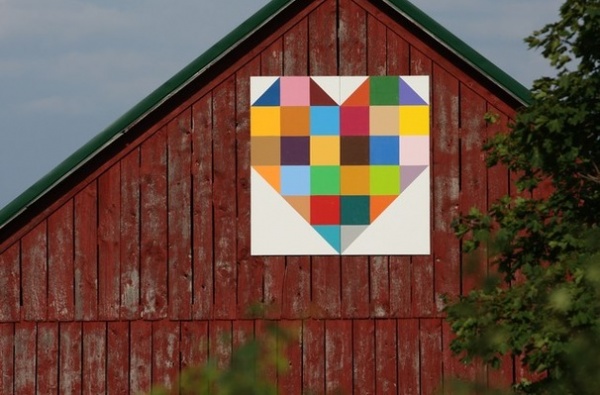
Barn Quilt 59: Patchwork Heart
This barn quilt reflects the owners’ love of the land and of each other. It hangs on a 120-year-old barn on a farm that’s been owned by the Erdmann family since 1886.
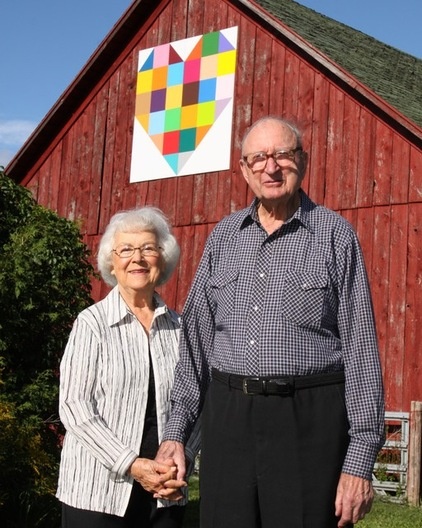
Eldor and Pat Erdmann, seen here, are the current owners. Except for three years in military service, Eldor has lived on this farm his entire life. He is one of 14 children, and by the age of 14, he was responsible for most of the farmwork. Back then he enjoyed working the fields with his horse-drawn plow. In 1957 he purchased the farm from his grandmother, Emelia Erdmann. He grew wheat, rye, oats, barley and Timothy hay, and milked 27 cows.
Pat told Jim Leuenberger, “When we saw this pattern, it just made us both smile. It reminds us of the quilts Grandma Erdmann made for Eldor’s family. When we must leave this farm, which we love so much, we like to think our hearts will always be here with our beautiful heart barn quilt.”
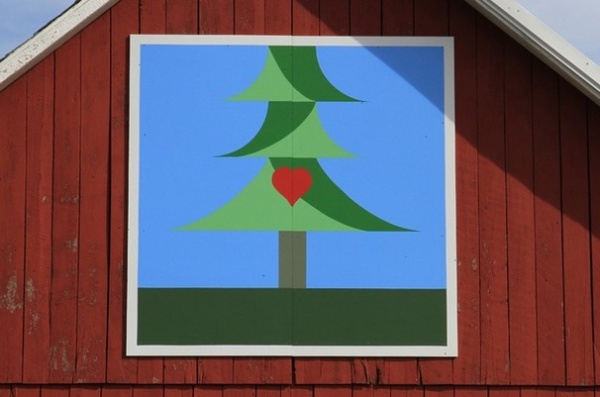
Barn Quilt 235: Trail of the Lonesome Pine
Of all the barn quilt stories, perhaps the most unusual tale is the one associated with this piece, which hangs on a barn owned by Bill Miller. It was donated by Shawano Pathways to honor Harold Pevonka, a local farmer who was described as irritable in life, but who shocked the community with his generosity after his death.
“He was known as a recluse who had several disagreements with his neighbors,” Leuenberger says. But the farmer had a secret: He and his sister suffered from heart disease. When Pevonka died, his will left thousands of dollars to local organizations that promote heart health, including Shawano Pathways, an organization that helps develop trails and green spaces in the county.
Pevonka was known to love the pine trees on his property (located near the Miller barn), so representatives of Shawano Pathways chose a pattern depicting an evergreen tree. With the farmer’s history in mind, they made a slight change to the classic pattern: They added a red heart among the branches to remind people of Pevonka’s wish to promote heart health.
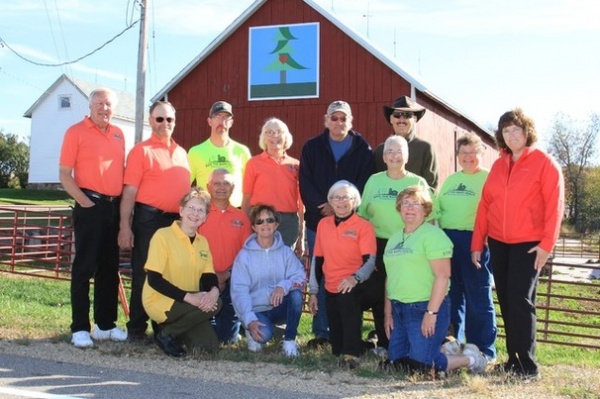
Shawano Pathways has organized a bike tour of the barn quilts, and the third annual event will be held on September 26 this year.
Members of the organization and the barn’s owner are seen here. Kneeling, from left: Jan Lewellyn, Greg Sturm, Mary LaMarche, Matty Mathison and Carol Westphal; standing, from left: Glen Westphal, John Brodhagen, Chuck Gueths, Maxine Williams, Bill Miller (the barn owner), Gary Gelb, Gail Swanke, Stephanie Spence and Nancy Schultz.
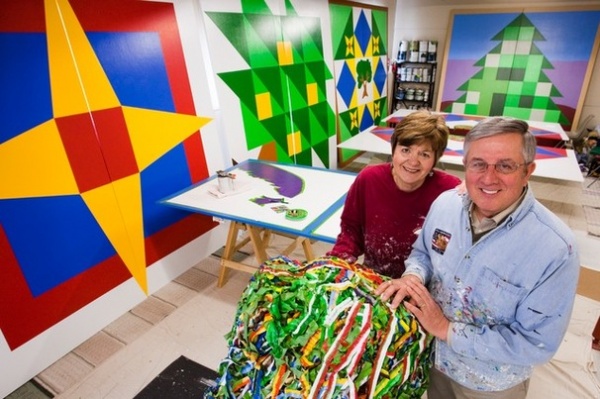
Irene and Jim Leuenberger are seen here in the basement of the chamber of commerce, which serves as their studio. Jim’s hands are resting on a sculpture made of an estimated 18,000 feet of painter’s tape that was used to craft barn quilt designs. The couple say they are proud of what the project has accomplished.
“It has really evolved into a community project, and that’s been fun to see,” Irene says. “It seems like everyone has embraced it.”
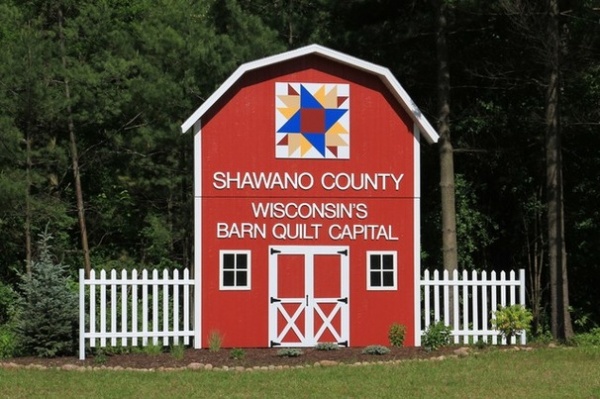
The barn quilts have led to a new nickname for the county: Wisconsin’s Barn Quilt Capital. Jim and his friend Len Pubanz put up a billboard of sorts to cement the moniker.
Jim, who is a photographer and took all the pictures here, now has even more to focus on. “I really enjoy driving around the Shawano County countryside during the different seasons of the year to get photographs of the barn quilts,” he says. “Our county is beautiful throughout the year, and the quilts on our historic old barns add to that beauty.”
For more photos and descriptions of Shawano County’s quilts, visit the chamber of commerce website.
More
Houzz TV: Life, Love and Purpose Down on the Farm
See Winning Modern Quilts on Display at QuiltCon 2015












